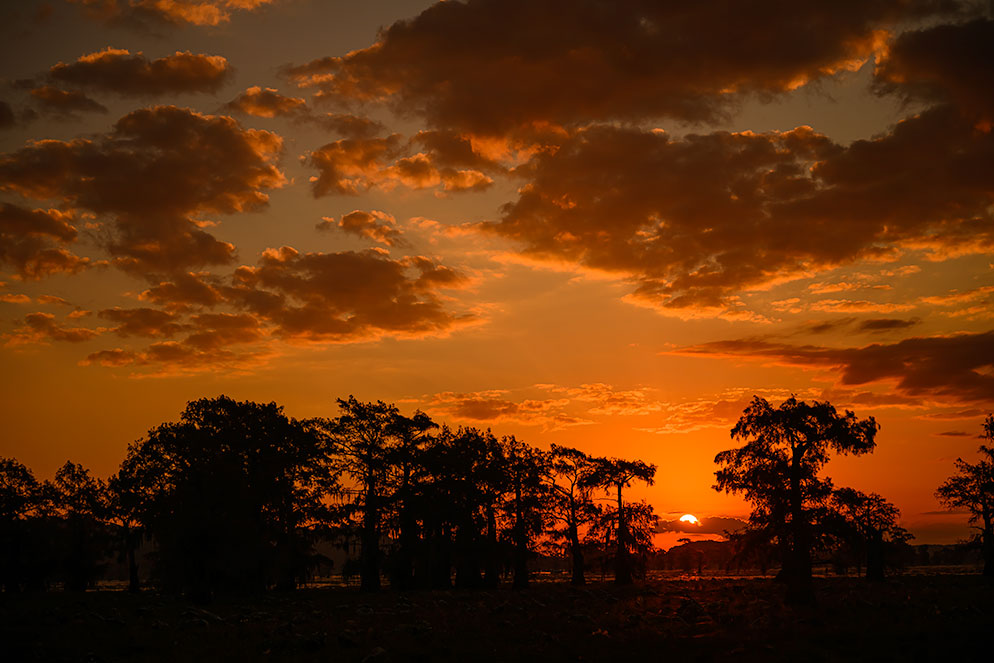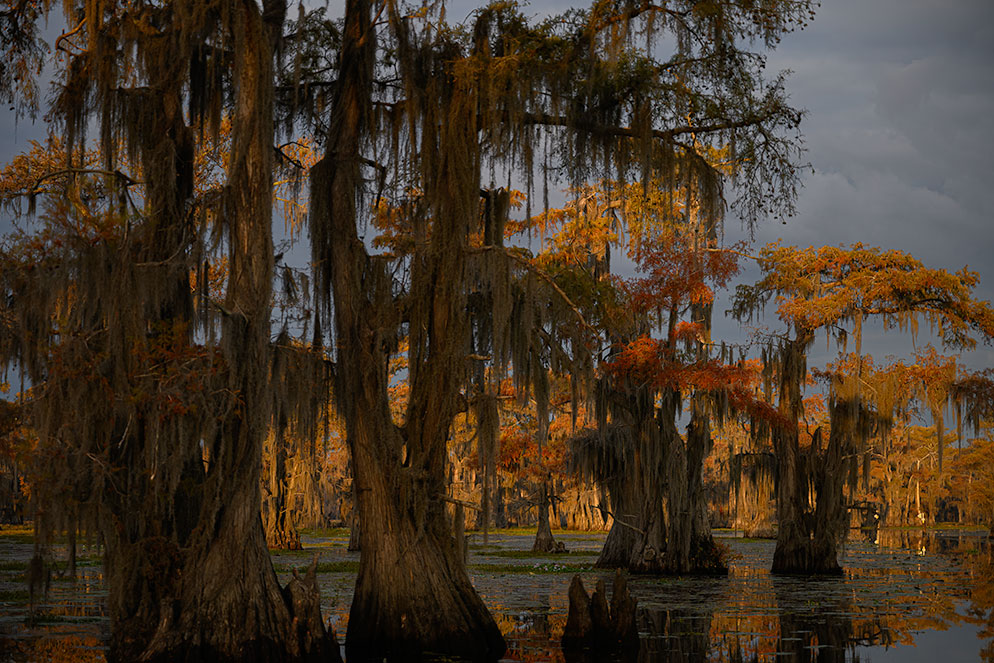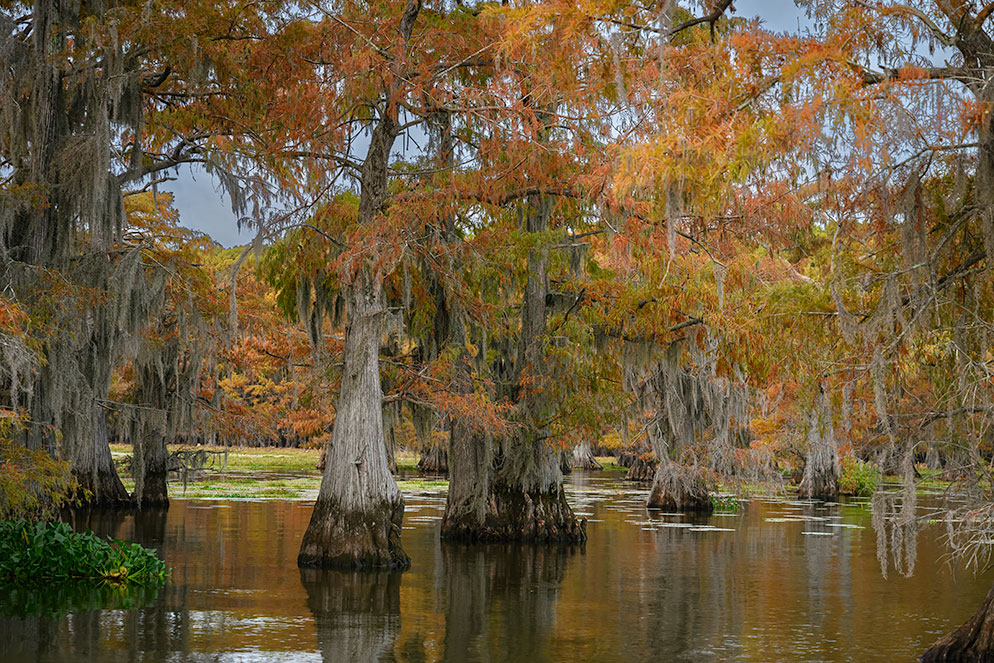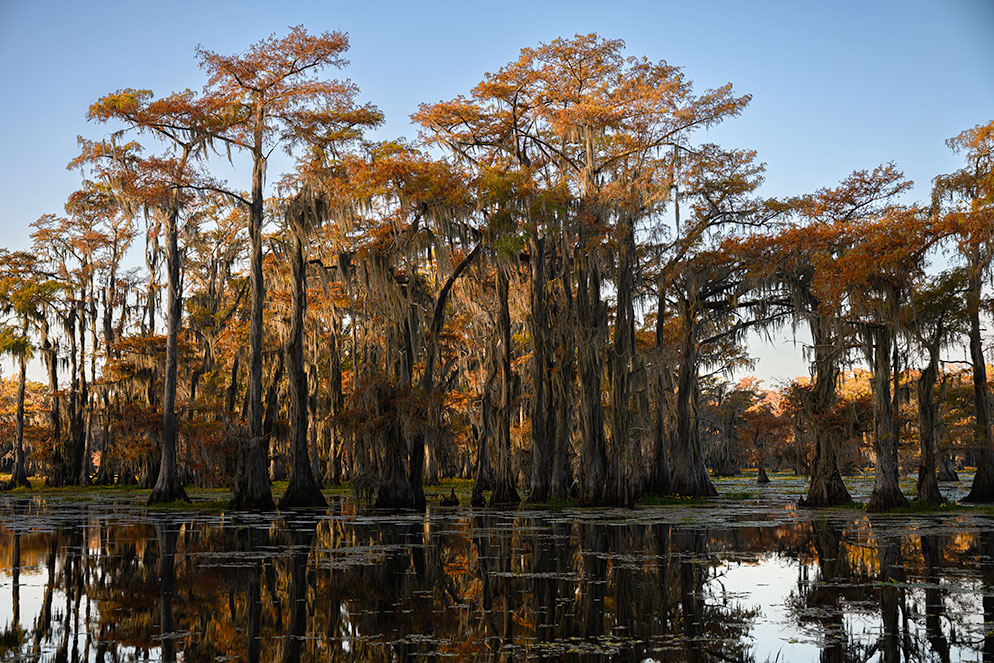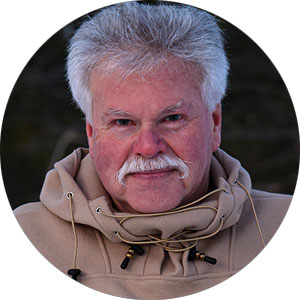Cruise for Color: The Magic of Caddo Lake
Z 8, NIKKOR Z 24-70mm f/2.8 S at 70mm focal length, 1/2500 second, f/2.8, ISO 100, aperture priority.
In the pitch dark, the pontoon boat slips from its dock into the jet-black waters among tall trees draped in Spanish moss. There is a clamminess to the air and the water is smooth as glass. The boat glides slowly down the river, then makes a turn into what appears to be a wall. With just enough space for the one boat, we slip through towering giants. As we proceed, the dot of light on the horizon grows wider, framed by tall shapes mirrored in the dark water. After a while we break out into an opening and the first color of dawn smacks us squarely between the eyes.
It appears you’re boating on a mirror. The giant wall we cruised through are now discernible Bald Cypress trees whose black outline is starting to glow. Now’s when the camera comes up to the eye and the magic and memories fill the pixels! The cypress trees are in fall color and their orange and reds are ablaze.
Caddo Lake is a one-of-a-kind location nestled between the border of Texas and Louisiana. As legend has it, a giant log jam long ago plugged up the Red River, the subsequent overflow created Caddo Lake, named for the native Caddoan people. This 25,000-acre lake is home to great fisheries, waterfowl hunting, power boating, wildlife, and one-of-a kind fall color. The ancient Bald Cypress, some more than 600 years old, are remnants of the bog that was flooded by that log jam. Caddo Lake’s Cypress regenerate only in the midst of damp bogs; not when “flooded” as they are now.
Z 8, NIKKOR Z 24-70mm f/2.8 S at 70mm focal length, 1/160 second, f/2.8, ISO 100, aperture priority.
Making the Journey
Like most hidden natural gems, Caddo Lake isn’t on the beaten path. About an hour drive from Shreveport, LA, Caddo is great any time of year.
In the spring, its green canopy is quite spectacular, alive with the calls of many nesting birds. Bald Eagle, Osprey, Wood Duck and even the elusive Protonotary Warbler nest in the safety of its cypress trees. In the fall, with color best around the second week in November, these species and many more, including a vast number of waterfowl are found here.
The Bald Cypress are what make Caddo special, and they are basically along the Red River, the western edge of Caddo, which is all Texas. I’ve always gone to Shady Glade Resort, Uncertain (yes, that is the town name) and explored Caddo Lake with Captain Rich, a longtime resident—his knowledge of Caddo, its forests, bogs, river, lake, and all its inhabitants (critter & human) bring the cruise to life. Captain Rich is a master of these waters knowing where to be, when to be there, and literally all the “cuts” through the forests to get you there. With that knowledge, one of the biggest challenges of bringing home images is covered.
Z 8, NIKKOR Z 24-70mm f/2.8 S at 70mm focal length, 1/80 second, f/4, ISO 400, aperture priority.
Gear Recommendations
Being very serious, you could travel to Caddo Lake with a Z 8 and 24-120mm lens and capture thousands of unique images. But let’s be honest, we can’t travel with just one body and a lens, we are photographers after all!
My gear: Z 9, Z 8, NIKKOR Z 600mm f/4 TC VR S, NIKKOR Z 24-70mm f/2.8 S, NIKKOR Z 14-24mm f/2.8 S mirrorless lenses and the AF-S FISHEYE NIKKOR 8-15mm f/3.5-4.5E ED with the Mount Adapter FTZ. [Editor's note: The Mount Adapter FTZ is discontinued so those new to Nikon mirrorless would need to use the Mount Adapter FTZ II model instead.] My strategy: I go for the landscape images, being prepared to take advantage of any wildlife that we come across.
Freedom to chase reflections, silhouettes and color requires one other most important piece of equipment—you and your ability to provide the camera with a stable shooting platform. Tripods aren’t really a viable option on a boat that’s moving (intentionally or not).
This requires that we use proper hand-holding to provide the stable platform for sharp images, which is very simple and should be second nature. If you need a refresher: proper handholding begins with turning our left hand, so the palm is pointed towards the sky. The lens barrel rests in our palm and fingers are available to grasp, zoom and/or focus. Our right hand grasps the camera body firmly and our index finger rests on the shutter release. With a slight amount of pressure of the index finger we activate the camera to settings and autofocus and press harder to fire the camera. This basic technique will get a workout as you float on Caddo Lake!
Z 8, NIKKOR Z 24-70mm f/2.8 S at 47mm focal length, 1/160 second, f/4, ISO 100, aperture priority.
Caddo Lake Cruise
The process of making images has one underlying theme, stealth. The mirrored surface of the lake comes from the pontoon boat gliding slowly, not rocking. This means the boat goes very slowly and we don’t move about once on board. This slowness provides not only no wake but it also makes it possible to shoot while underway. Talking in muted tones is best.
Set up your camera bag so you can access your kit with a single zip to grab your main body with a lens already attached. You’d be surprised how much a boat will rock when several photographers are reaching for their bags and assembling their gear. One small ripple started may take five or eight minutes to dissipate entirely through the water. When the sun is racing up in the sky in the morning or down in the evening, waiting for the ripple to disappear seems to take forever as you realize the photographs you’re missing.
Freedom to chase reflections, silhouettes and color requires one other most important piece of equipment—you and your ability to provide the camera with a stable shooting platform.
Starter Settings
We’ve all experienced amazing sunrises and sunsets; Bringing back those stunning reds and oranges so they match our memory is as simple as thinking about White Balance. The simple mantra I remind folks is, when you see red in the sky, go to Cloudy and the rest of the time, use AWB. I like to often take this a bit further in my photography by dialing in manually a Kelvin Temperature of 10,000. This accomplishes a number of things. First, is to capture the vibrant reds / oranges you see and a bit more plus all the information the camera can capture, with this boost.
You might also start with your camera in Aperture Priority, lens open to its widest aperture and exposure compensation of minus one dialed in (why I like to have the f/2.8 lenses on Caddo Lake). These settings have you set to shoot when the color saturates the sky. Why do this in advance? The two main reasons are so you can concentrate on arranging the elements in the frame while minimizing any movement in the boat and come home with the images. The sunrises / sunsets can take your breath away!
This brings up lens selection. As you cruise out from the forest of Bald Cypress, the horizon opens up. Sunrises and sunsets can fill that entire horizon. You can use an ultra-wide lens, fixed or zoom, or a wide-angle - telephoto and shoot panoramas. Focusing at infinity where depth of field doesn’t come into play (unless shooting the horizon and something up close which presents big challenges in this environment) so shooting wide open is perfect, providing us with the fastest possible shutter speed. Personally, I leave the dock with the NIKKOR Z 24-70mm f/2.8 S on the Z 8 and the NIKKOR Z 600mm f/4 TC VR S on the Z 9. With this, all that’s left is finding the color.
Z 8, NIKKOR Z 24-70mm f/2.8 S at 24mm focal length, 1/160 second, f/2.8, ISO 400, aperture priority.
As the sun rises, you’ll find it is doubled on Caddo Lake. That’s because its dark waters reflect all the grandeur. This is a great locale to place the horizon line nearly dead center, fully taking advantage of all that color. There are small “groves” of cypress that seem to disappear into the horizon. These silhouettes fill the frame with endless visual space you can fill up with color. And by slowly turning in your seat (remembering to minimize movement and ripples) you can capture the sunrise on the fall color. Then you might turn around with that long lens and photograph the fiery ball of color blazing through the Cypress.
Once the sun is up (or before it goes down) our subject is the fall color of the Bald Cypress. The color is our subject, or star of our photograph, with the background its stage. Unlike your maple or aspen leaf, which by themselves can be a photograph, the “leaves” of the Bald Cypress—not so much. This means that a majority of the time we’re looking for patterns in the vertical lines of the trunks and the patches of color. This is when you tap into your passion and photographic skill. You might try taking in the scene with a small aperture, creating a visual depth and at the same time some mystery by grabbing your viewer’s imagination. This can be a time when there is often a lot of changing of lenses, which makes lenses like the NIKKOR Z 24-120mm f/4 S or NIKKOR Z 70-200mm f/2.8 VR S great choices.
Keeping the photograph in mind while working from a potentially rocky platform and with other photographers is why I like to use two camera bodies. I use the NIKKOR Z 600mm f/4 TC VR S for wildlife, but I also use it more for landscapes on Caddo Lake. Why? That long focal length isolates a subject, smacking the viewer right between the eyes with tree trunk and color. The Bald Cypress Forest can be a visual place where less can be more. There are some areas where even the pontoon boat cannot reach but a long lens can. On my last journey, I relied on the NIKKOR Z 400mm f/4.5 VR S and the prior trip, the NIKKOR Z 70-200mm f/2.8 VR S with the NIKKOR Z Teleconverter TC-1.4x.
Is there more?
That’s the beauty of Caddo, it is that simple and elegant. As you cruise many of the back bayous, every turn will be a new surprise and photographic opportunity. When I cruise Caddo, I explore on the water for five days straight knowing that no two days will be the same and none the same as the year before. It is easy to get turned around on your first visit, it was for me. For this reason, I use the GPS Log feature of the Z 9 to record every cruise. I keep the Log for each cruise, and I make notes because I know I’ll be going back, over and over again. There is no place like Caddo Lake or more satisfying than the cruise for color!

